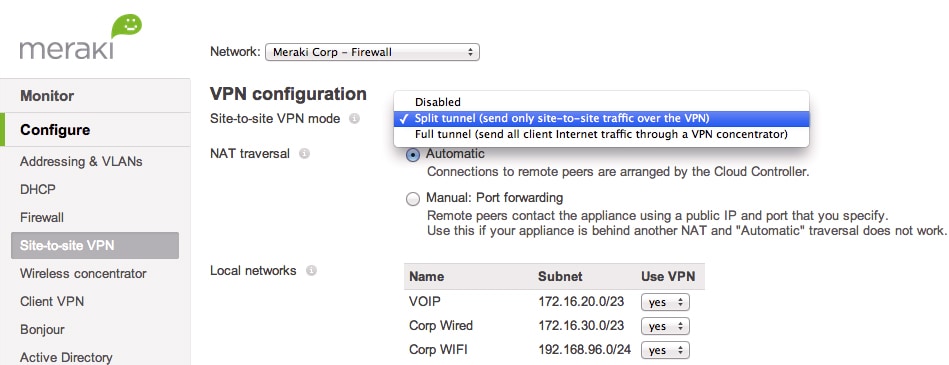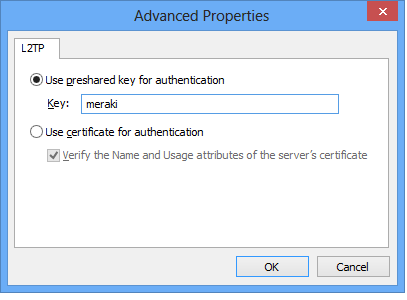To enable Client VPN, choose Enabled from the Client VPN server pulldown menu on the Security Appliance Configure Client VPN page. The following Client VPN options can be configured: Client VPN Subnet: The subnet that will be used for Client VPN connections. This should be a private subnet that is not in use anywhere else in the network. You've had a look at the instructions on how to setup the Cisco Meraki Client VPN on Windows, but it is just 'too many clicks' or you have to do it on lots of computers and you just need a better way? This wizard lets you type in all the parameters you require for your client VPN connection and then generates a Powershell script using the VPNv2-CSP engine in Windows 10. This is the line that I use for my Meraki Client VPN. It does have to be run with admin credentials for -AllUserConnection to work. Your add-vpnconnectionroute lines should have an -AllUserconnection argument as well. Sentry VPN on Meraki MX-Z Devices. Sentry VPN Security allows you to define a tag-scope to receive a Dynamically generated VPN Configuration from the Security appliance Configure Client VPN page, and configured by selecting the appropriate tag scoping for your SM devices.
Cisco Meraki Client Vpn Setup
The VPN:
The Meraki client VPN uses the L2TP tunneling protocol and can be deployed on PC’s, Mac’s, Android, and iOS devices without additional software as these operating systems natively support L2TP.
The Encryption Method:
Along with the L2TP/IP protocol the Meraki client VPN employs the following encryption and hashing algorithms: 3DES and SHA1 for Phase1, AES128/3DES and SHA1 for Phase 2. Best practice dictated that the shared secret should not contain special characters at the beginning or end.
Enabling Client VPN:
Select Enabled from the Client VPN server pull-down menu on the Security Appliance -> Configure -> Client VPN page. You can then configure the following options:
- Client VPN Subnet: The subnet that will be used for Client VPN connections. This should be a private subnet that is not in use anywhere else in your network. The MX will be the default gatway on this subnet and will route traffic to and from this subnet.
- DNS Nameservers: The servers VPN Clients will use to resolve DNS hostnames. You can choose from Google Public DNS, OpenDNS, or specifying custom DNS servers by IP address.
- WINS: If you want your VPN clients to use WINS to resolve NetBIOS names, select Specify WINS Servers from the drop-down and enter the IP addresses of the desired WINS servers.
- Secret: The shared secret that will be used to establish the Client VPN connection.
- Authentication: How VPN Clients will be authenticated.
- Systems Manager Sentry VPN Security: Configuration settings for whether devices enrolled in systems manager should receive a configuration to connect to the Client VPN.

Authentication:
The VPN uses both pre-shared key based authentication and user authentication. To set up the user authentication mechanism, you will need to select your authentication method.
Meraki Cloud Authentication:
Use this option if you do not have an Active Directory or RADIUS server, or if you wish to manager your VPN users via the Meraki cloud. To add or remove users, the User Management section at the bottom of the page. Add a user by selecting “Add new user” and entering the following information:
- Name: Enter the user’s name
- Email: Enter the user’s email address
- Password: Enter a password for the user or select “Generate” to automatically generate a password
- Authorized: Select whether this user is authorized to use the Client VPN
In order to edit an existing user, click on the user under User Management section. To delete a user, click the X next to the user on the right side of the user list. When using Meraki hosted authentication, the user’s email address is the username that is used for authentication.
RADIUS:
Use this option to authenticate users on a RADIUS server. Click Add a RADIUSserver to configure the server(s) to use. You will need to enter the IP address of the RADIUS server, the port to be used for RADIUS communication, and the shared secret for the RADIUS server.
Active Directory:
Use this option if you want to authenticate your users with Active Directory domain credentials. You will need to provide the following information:
- Short Domain: The short name of your Active Directory domain.
- Server IP: The IP address of an Active Directory server on the MX LAN.
- Domain Admin: The domain administrator account the MX should use to query the server.
- Password: Password for the domain administrator account.
For example, considering the following scenario: You wish to authenticate users in the domain test.company.com using an Active Directory server with IP 172.16.1.10. Users normally log into the domain using the format ‘test/username’ and you have created a domain administrator account with the username ‘vpnadmin’ and the password ‘vpnpassword’.

- The Short domain would be ‘test’.
- The Server IP would be 172.16.1.10
- The Domain admin would be ‘vpnadmin’
- The Password would be ‘vpnpassword’.
At this time, the MX does not support mapping group policies via Active Directory for users connecting through the Client VPN.
Systems Manager Sentry VPN Security:
When using Meraki cloud authentication, Systems Manager Sentry VPN security can be configured. If your Dashboard organization contains one or more MDM networks. Systems Manager Sentry VPN security allows for your devices enrolled in Systems Manager to receive the configuration to connect to the Client VPN through the Systems Manager profile on the device.
To enable Systems Manager Sentry VPN security, choose Enabled from the Client VPN server pulldown menu on the Security Appliance -> Configure -> Client VPN page. You can configure the following options:
- Install Scope: The install scope allows you to select a set of Systems Manager tags for a particular MDM network. Devices with these tags applied in a Systems Manager network will receive a configuration to connect to this network’s Client VPN server through their Systems Manager profile.
- Send All Traffic: Select whether all client traffic should be sent to the MX.
- Proxy: Whether a proxy should be used for this VPN connection. This can be set to automatic, manual, or disabled.
When using Systems Manager Sentry VPN security, the username and password used to connect to the client VPN are generated by the Meraki cloud. Usernames are generated based on a hash of unique identifier on the device and the username of that device. Passwords are randomly generated.
Was this article helpful?
Related Articles

Posted by: @merakisimon
We’ve all read the horror stories. Passwords, private photos, corporate data, government secrets. What hasn’t been compromised at some point? Connectivity is so important to us that sometimes we forget we may not be the only ones joined to that café hotspot. Thankfully today many of the services we access are reached over an SSL connection, but a Virtual Private Network (VPN) remains the best way to protect all traffic.
Using a VPN in itself is not so hard. An iPhone with VPN configured will simply present a toggle for the user to slide.
So the issue isn’t connecting to VPN, but configuring it in the first place. Even people who consider themselves ‘technical’ can struggle here, because VPN configuration requires the user to configure several settings. Here’s what the iPhone owner is confronted with when attempting to add a new VPN configuration:
Meraki to the rescue! Customers who deploy one of our powerful MX Security Appliances together with Systems Manager have everything they need to build a turnkey VPN solution in their hands. Among the Security Appliance’s many features are comprehensive site-to-site and client VPN. Pairing an MX with Systems Manager adds a number of powerful security features we call Sentry.
To get things set up, log on to the dashboard and head over to the Client VPN settings page on the MX to which VPN clients will connect. Enable the Client VPN server and then enter the desired settings and then select ‘Systems Manager Sentry VPN Security’. This will open up a new panel as shown here:
In the Sentry VPN section the admin chooses the Systems Manager network (if there is more than one) and the scope of devices which will receive the VPN settings. The usual Systems Manager tags are available here, both static and dynamic, enabling tight control over which devices will be enabled for VPN. Finally, determine whether this should be a full tunnel VPN (Send All Traffic, a good choice when on unfamiliar networks), and any proxy settings before clicking save. That’s all there is to it! Oh, and we can perform the same trick for Mac OS X too and Samsung Knox enabled Android devices.
Meraki Mx64 Client Vpn Setup
This truly is simplicity at its best. No need to worry about user configuration, or shared secrets, or server credentials. Everything is automatically pulled from the selected Security Appliance and then pushed out through a profile update to managed clients. The client device will then see the VPN option in settings, and then need only click the toggle to bring the VPN up.
Not ready to purchase a Security Appliance yet? Systems Manager will also allow the manual configuration and deployment of VPN server credentials for any L2TP, PPTP, Cisco IPSec or AnyConnect server.
Meraki Client Vpn Setup
Sentry is the name we give to a range of security related features which can be used when deploying Systems Manager into an environment with a Meraki network infrastructure. We’ve covered several of these features already on the blog. In this case, Sentry VPN overcomes the biggest obstacle to secure network communications, making it a cinch to set-up, and a trivial option for the end user. Coffee shop productivity just got a lot more secure.
Try Systems Manager on for size by heading over to our website. As with all Meraki solutions, the software is all driven from and accessed via a robust cloud architecture. There’s no hardware required to get started, making it easy to take for a test drive from the comfort of your chair.
Related Posts

Meraki Vpn Client Dns Not Working
